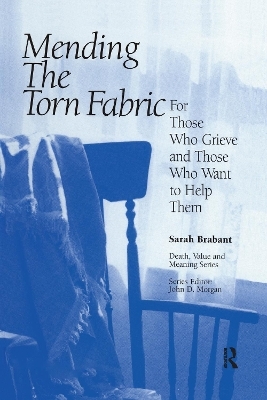
Mending the Torn Fabric
Baywood Publishing Company Inc (Verlag)
978-0-89503-141-9 (ISBN)
The analogy of the torn fabric was first used by the author in response to a bereaved mother's cry: "I know what grief feels like; I don't know what it looks like." In "Mending the Torn Fabric: For Those Who Grieve and Those Who Want to Help Them", the author expands the metaphor to include earlier and future or potential losses as well as losses associated with the death that may be unrecognized or minimized. This book includes chapters that examine complications that may be present or may arise, suggestions for mending even the most torn fabric, and a chapter dedicated to friends who want to help. Stories bereaved persons have shared with the author through the years are interspersed throughout the book to provide examples of loss and mending.
Sarah Brabant
The Torn Fabric
Presentation of the analogy (The torn fabric)
Places to Mend
This chapter focuses on the bereaved individual's response to loss and includes such responses as denial, anger, bargaining, depression, relief, fear, and sadness. It also discusses acceptance as a process rather than an end result.
Places to Avoid
Focus is on guilt and blame and centers on the response of others to an individual's loss. How is the loss defined? Is it worth grieving about? How "should" one grieve appropriately? Included is a discussion of early childhood learning that may inhibit grief work, i.e., mending.
How Many Tears?
This chapter addresses the social roles that are lost when a person dies. For example, when a child dies, the parent "dies" also. Thus, there are always at least two tears. How does one go about recognizing which tear needs mending?
Earlier Tears
This chapter includes earlier losses such as abandonment(s), failures, abuse, etc.
Future Tears
This chapter includes but is not limited to anniversary reactions and holidays.
Needles and Threads
Books, workshops, counseling are discussed at this time. This chapter also includes rituals, dreams, exercise, and other means of working through grief.
Complicated Mending
This chapter looks at those factors which make mending (grief work) particularly difficult, e.g., earlier problems such as alcoholism, or types of death such as sudden death, murder, suicide, multiple deaths, etc.
The Mended Fabric
This chapter addresses the problems associated with moving back into the mainstream of life, i.e., embroidering rather than mending.
Guidelines for Those Who Want to Help
Suggestions (both do's and don'ts) for family, friends, and co-workers.
Notes for the Professional: Theoretical Underpinnings and Use of Analogy
Bibliography • Resources for Bereaved Persons •
Suggested Readings/Videos • Index
| Erscheint lt. Verlag | 15.6.1996 |
|---|---|
| Reihe/Serie | Death, Value and Meaning Series |
| Verlagsort | Amityville |
| Sprache | englisch |
| Maße | 156 x 234 mm |
| Gewicht | 362 g |
| Themenwelt | Schulbuch / Wörterbuch ► Lexikon / Chroniken |
| Geisteswissenschaften ► Psychologie | |
| Medizin / Pharmazie ► Medizinische Fachgebiete ► Psychiatrie / Psychotherapie | |
| ISBN-10 | 0-89503-141-8 / 0895031418 |
| ISBN-13 | 978-0-89503-141-9 / 9780895031419 |
| Zustand | Neuware |
| Haben Sie eine Frage zum Produkt? |
aus dem Bereich


